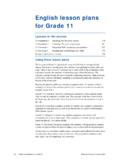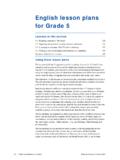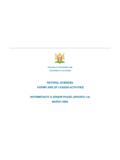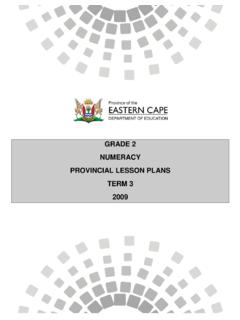Transcription of English lesson plans for Grade 1 - sec.gov.qa
1 25 | English sample lessons | Grade 1 Supreme Education Council 2004 English lesson plans for Grade 1 Lessons in this section Vocabulary, listening and speaking: parts of the body and can 26 Vocabulary, listening and speaking: colours and parts of the body 29 Speaking and writing: describing possessions with have and colours 33 Speaking and reading: ability with can 36 Resource sheets for the lessons 39 Using these lesson plans The lessons for Grade 1 represent a week s teaching; they are drawn from a unit of work recycling and integrating topics on ability, parts of the body, and colours; the unit uses the language structures can + verb for statements and yes/no questions, and simple present tense with have. The objectives for the lessons are drawn from the curriculum standards for Grade 1.
2 The relevant standards are shown in bold beside the objectives at the top of each lesson plan . Each lesson plan has sufficient material to support at least 45 minutes of direct teaching. Teachers may need to supplement the activities provided with additional simpler or more complex tasks if they have a mixed ability class. If there is too much material for 45 minutes (this depends on the class), it is up to the teacher to designate which activities will carry through to the next lesson . However, to maximise the learning cycle, teachers should be selective about which tasks to cut, and not just drop the last task because it comes at the end. Extra practice tasks are included to accommodate students or groups of students who learn faster than the rest of the class. The lesson plans are organised as three-stage lessons with a feedback session at the end to sum up learning for students. In the vocabulary and speaking lessons, the three stages are presentation, practice and production.
3 In the listening, reading and writing lessons the three stages are pre-, while, and post- ( pre-reading, while reading and post-reading). However, at this early learning stage, many of the tasks require integrated skills, so the stages sometimes merge. In addition, some of the lesson plans are made up of two or three quite separate activities which are connected by a topic rather than a language focus, and here again, the stages are not so linear. Because the learners are beginners in English , the lesson plans show a lot of recycling and refer to revision vocabulary which it is assumed has been taught earlier. Teachers will have to adjust the vocabulary load depending on what has really gone before. 26 | English sample lessons | Grade 1 Supreme Education Council 2004 Vocabulary, listening and speaking: parts of the body and can Name parts of the body and express ability with can. Follow simple commands and answer questions.
4 Follow, participate in and repeat an action rhyme. Picture cue drill Construct a cardboard figure that sticks to a felt board or a magnetic board with detachable eyes, mouth, ears, nose, hands, and feet. Hold up each part of the body before sticking and ask the following questions. What s this? It s a nose; it s a mouth What are these? They re eyes; they re ears; they re hands; they re feet When the students offer the word in Arabic, say the word for them in English . Get them to listen to it two ore three times before repeating it. Drill the words until the students have learned to say and identify the parts of the body with ease. Labelling Remove the eyes, mouth, ears, nose, hands and feet. Ask individual students to come to the front and stick back on the body parts as instructed. Don t hold up the body part in question when naming it; leave them in a pile on the table. Faleh, put the nose on. Isa, put the feet on.
5 Teacher s script Put the nose on. Put the feet on. Put the hands on. Put the mouth on. Put the eyes on. Put the ears on. Take one hand off. Take the other hand off. Take the feet off. Put one hand back. Take the ears off. Take the nose off. Put the nose back on. Take the nose and the mouth off. Objectives Grade 1 curriculum standards , , , , , , , Presentation / Practice Resources Cardboard figure with detachable parts; magnet or felt board Vocabulary eyes mouth ears nose hands feet Revision vocabulary (to) see 27 | English sample lessons | Grade 1 Supreme Education Council 2004 Slap the board When the cardboard figure has been fully reconstructed on the felt board or the magnet board, select two teams of five. Draw a starting line on the floor about two metres from the board and stand the teams behind it. Get the first member of each team to approach the board. Call out one of the new words ( nose). The first student to slap the correct part of the face on the board wins a point for their team.
6 The winner goes to the back of the line and the loser goes back to his or her seat and is replaced by someone new from the class. The next couple step up to the board and the teacher calls out another word. Once the class sees how to play the game, get students who are not in either team to call out the body part words. Continue playing until everyone has had a go or the vocabulary is thoroughly practised. The team with the most points wins. Matching Elicit in Arabic and then translate into English the verbs that go with various parts of the body. eyes see, mouth talk, ears hear, feet walk It is not important that students learn all the verbs actively but it is important that they understand them before repeating the rhyme that follows. Get the students to think of a hand or finger mime for each action. Practise saying the verb aloud in English and getting the students to respond by doing the mime. Keep to the order of the verbs in the rhyme to make things easier.
7 Teacher says Students do see shade their eyes with their hand talk make a talking mouth gesture with their thumb and fingers hear cup their hand to their ear walk make their fingers do the walking Action rhyme Get students to listen to the rhyme. Teacher s script We have eyes and we can see. We have mouths and we can talk. We have ears and we can hear. We have feet and we can walk. Say it a few times, pointing to your own eyes, mouth, ears, feet and doing the accompanying mime for see, talk, hear, walk. Then get students to repeat the rhyme with you. While they practise repeating it, get them to point to each part of their own body as it is mentioned and do a mime for each verb. Go back over the vocabulary by pointing to your own eyes, nose, mouth, ears, hands, feet and getting students to name them. Practice / Production Feedback 28 | English sample lessons | Grade 1 Supreme Education Council 2004 Summary for students In Arabic Today we talked about the things the different parts of our bodies can do.
8 What can my eyes do? What can my ears do? What can my mouth do? What can my feet do? Can you remember the rhyme? Say it again for me. 29 | English sample lessons | Grade 1 Supreme Education Council 2004 Vocabulary, listening and speaking: colours and parts of the body Name colours and name and describe parts of the body. Listen and respond to single step instructions and descriptions. Make sentences with It has .. for descriptions. Action rhyme Get students to repeat the action rhyme they learned in lesson , pointing to each body part and doing a mime for each verb. Teacher s script We have eyes and we can see. We have mouths and we can talk. We have ears and we can hear. We have feet and we can walk. Model sentences Point to each item of the target vocabulary on your own face and body; get students to copy you and as they point they say the following model sentences. Model sentence: This is my nose. Model sentence: These are my hands.
9 Realia drill Teacher points to Students point and say nose This is my nose. mouth This is my mouth. body This is my body. ears These are my ears. eyes These are my eyes. arms These are my arms. hands These are my hands. legs These are my legs. feet These are my feet. Simon says Explain the rules of Simon says in Arabic and play a first practice round to catch someone out so the students can see how the game works. If the teacher s instructions are preceded by the phrase Simon as in Simon says touch your toes then the students must do it. But if the teacher simply says Touch your legs! , then the students must not do it. Any student performing Objectives Grade 1 curriculum standards , , , , , Pre-listening Vocabulary my body my arms my legs Revision vocabulary my eyes my mouth my ears my nose my feet my hands While listening 30 | English sample lessons | Grade 1 Supreme Education Council 2004 the direct command with no Simon is out and must stand aside/not participate.
10 The game continues until most students are out . You don t need to adhere strictly to the rules. If you catch most students at one go, you can laugh and announce Caught you! and then everyone is back in until you manage to catch them again. For any new, incidental vocabulary in the instructions, use a mime to help students understand what to do ( open, wave, shake, wiggle). Teacher s script Simon says touch your legs. Simon says touch your arms. Simon says touch your ears. Touch your nose! Simon says open your eyes. Simon says open your hands. Open your mouth! Simon says wave your hands. Simon says shake your hands. Simon says shake your head. Simon says shake your feet. Shake your hands! Simon says wiggle your head. Simon says wiggle your body. Simon says wiggle your ears. (If no-one can do it: You re all out!) Realia drill Revise colour vocabulary by holding up colour cards, crayons or coloured toys for blue, black, red, white, green and eliciting from students how you say the colours in English .












